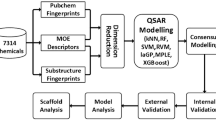Abstract
A recently published study showed the feasibility of chronic rat toxicity prediction, an important task to reduce the number of animal experiments using the knowledge of previous experiments. We benchmarked various kernel learning approaches for the prediction of chronic toxicity on a set of 565 chemical compounds, labeled with the Lowest Observed Adverse Effect Level, and achieved a prediction error close to the interlaboratory reproducibility. ε-Support Vector Regression was used in combination with numerical molecular descriptors and the Radial Basis Function Kernel, as well as with graph kernels for molecular graphs, to train the models. The results show that a kernel approach improves the Mean Squared Error and the Squared Correlation Coefficient using leave-one-out cross-validation and a seeded 10-fold-cross-validation averaged over 10 runs. Compared to the state-of-the-art, the Mean Squared Error was improved up to MSEloo of 0.45 and MSEcv of 0.46±0.09 which is close to the theoretical limit of the estimated interlaboratory reproducibility of 0.41. The Squared Empirical Correlation Coefficient was improved to \(\text{Q}^2_{\text{loo}}\) of 0.58 and \(\text{Q}^2_{\text{\text{cv}}}\) of 0.57±0.10. The results show that numerical kernels and graph kernels are both suited for predicting chronic rat toxicity for unlabeled compounds.
Preview
Unable to display preview. Download preview PDF.
Similar content being viewed by others
References
Azencott, C.-A., Ksikes, A., Joshua Swamidass, S., Chen, J.H., Ralaivola, L., Baldi, P.: One- to four-dimensional kernels for virtual screening and the prediction of physical, chemical, and biological properties. Journal of Chemical Information and Modeling 47(3), 965–974 (2007)
Chang, C.-C., Lin, C.-J.: Libsvm: A library for support vector machines (2001)
Cronin, M.T.D., Jaworska, J.S., Walker, J.D., Comber, M.H.I., Watts, C.D., Worth, A.P.: Use of qsars in international decision-making frameworks to predict health effects of chemical substances. Environmental Health Perspectives 10, 1391–1401 (2003)
Fröhlich, H., Wegner, J.K., Sieker, F., Zell, A.: Optimal assignment kernels for attributed molecular graphs. In: ICML, pp. 225–232 (2005)
Fröhlich, H., Wegner, J.K., Sieker, F., Zell, A.: Kernel functions for attributed molecular graphs - a new similarity-based approach to adme prediction in classification and regression. QSAR & Combinatorial Science 25, 317–326 (2006)
Gasteiger, J., Rudolph, C., Sadowski, J.: Automatic generation of 3d-atomic coordinates for organic molecules. Tetrahedron Computational Methods 3, 537–547 (1992)
Gower, J.C.: A general coefficient of similarity and some of its properties. Biometrics 27(4), 857–871 (1971)
Kashima, H., Tsuda, K., Inokuchi, A.: Marginalized kernels between labeled graphs. In: ICML, pp. 321–328 (2003)
Leslie, C., Eskin, E., Noble, W.S.: The spectrum kernel: a string kernel for protein classification. In: Pacific symposium on biocomputing (2002)
Mahé, P., Ralaivola, L., Stoven, V., Vert, J.-P.: The pharmacophore kernel for virtual screening with support vector machines. Journal of Chemical Information and Modeling 46(5), 2003–2014 (2006)
Mazzatorta, P., Estevez, M.D., Coulet, M., Schilter, B.: Modeling oral rat chronic toxicity. Journal of Chemical Information and Modeling 48, 1949–1954 (2008)
Mumtaz, M.M., Knauf, L.A., Reisman, D.J., Peirano, W.B., DeRosa, C.T., Gombar, V.K., Enslein, K., Carter, J.R., Blake, B.W., Huque, K.I., Ramanujam, V.M.S.: Assessment of effect levels of chemicals from quantitative structure-activity relationship (qsar) models. i. chronic lowest-observed-adverse-effect level (loael). Toxicology Letters 79, 131–143 (1995)
Munro, I.C., Ford, R.A., Kennepohl, E., Sprenger, J.G.: Correlation of structural class with no-observed-effect levels: A proposal for establishing a threshold of concern. Food and Chemical Toxicology 34, 829–867 (1996)
Ralaivola, L., Swamidass, S.J., Saigo, H., Baldi, P.: Graph kernels for chemical informatics. Neural Networks 18(8), 1093–1110 (2005)
Rupp, M., Proschak, E., Schneider, G.: Kernel approach to molecular similarity based on iterative graph similarity. Journal of Chemical Information and Modeling 47(6), 2280–2286 (2007)
Saigo, H., Kadowaki, T., Tsuda, K.: A linear programming approach for molecular qsar analysis. In: International Workshop on Mining and Learning with Graphs (2006)
Schölkopf, B., Smola, A.J.: Learning with Kernels: Support Vector Machines, Regularization, Optimization, and Beyond. MIT Press, Cambridge (2001)
Steinbeck, C., Han, Y., Kuhn, S., Horlacher, O., Luttmann, E., Willighagen, E.: The chemistry development kit (cdk): an open-source java library for chemo- and bioinformatics. Journal of Chemical Information and Computer Science 43(2), 493–500 (2003)
Talete srl, Milano, Italy. dragonX 1.4 for Linux (Molecular Descriptor Calculation Software)
Tilaoui, L., Schilter, B., Tran, L.-A., Mazzatorta, P., Grigorov, M.: Integrated computational methods for prediction of the lowest observable adverse effect level of food-borne molecules. QSAR & Combinatorial Science 26, 102–108 (2007)
Todeschini, R., Consonni, V., Mannhold, R., Kubinyi, H., Timmerman, H.: Handbook of Molecular Descriptors. Wiley-VCH, Weinheim (2000)
U. S. Environmental Protection Agency. ECOTOX User Guide: ECOTOXicology Database System. Version 4.0 (2006)
Venkatapathy, R., Moudga, C.J., Bruce, R.M.: Assessment of the oral rat chronic lowest observed adverse effect level model in topkat, a qsar software package for toxicity prediction. Journal of Chemical Information and Computer Sciences 44(5), 1623–1629 (2004)
Vert, J.-P.: The optimal assignment kernel is not positive definite (2008)
Walker, J.D., Carlsen, L., Hulzebos, E., Simon-Hettich, B.: Global government applications of analogues, sars and qsars to predict aquatic toxicity, chemical or physical properties, environmental fate parameters and health effects of organic chemicals. SAR and QSAR in environmental research 13, 607–616 (2002)
Author information
Authors and Affiliations
Editor information
Editors and Affiliations
Rights and permissions
Copyright information
© 2009 Springer-Verlag Berlin Heidelberg
About this paper
Cite this paper
Hinselmann, G., Jahn, A., Fechner, N., Zell, A. (2009). Chronic Rat Toxicity Prediction of Chemical Compounds Using Kernel Machines. In: Pizzuti, C., Ritchie, M.D., Giacobini, M. (eds) Evolutionary Computation, Machine Learning and Data Mining in Bioinformatics. EvoBIO 2009. Lecture Notes in Computer Science, vol 5483. Springer, Berlin, Heidelberg. https://doi.org/10.1007/978-3-642-01184-9_3
Download citation
DOI: https://doi.org/10.1007/978-3-642-01184-9_3
Publisher Name: Springer, Berlin, Heidelberg
Print ISBN: 978-3-642-01183-2
Online ISBN: 978-3-642-01184-9
eBook Packages: Computer ScienceComputer Science (R0)




